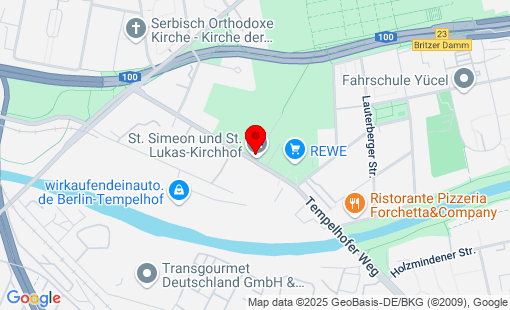Germany
Berlin-Neukölln, St.-Simeon- und St.-Lukas-Friedhof
Total Occupation: 94 fatalities
Total Occupation: 94 fatalities
The Protestant St. Simeon and St. Lukas cemetery was established in 1897 on the initiative of local politician Carl Elsasser. As late as 1905, there were only four residential buildings in the area of the cemetery, two of which belonged to market gardens. The cemetery originally served two parishes: The church named after St. Luke the Evangelist was built in 1859-1861 as a basilica church according to plans by Friedrich August Stüler. During the First World War, the bronze bells were removed and melted down; they were replaced by cast steel bells in the post-war period. After its destruction on 29 April 1945, it was rebuilt (albeit in a modified form, for example without the spire) and rededicated in 1954. The church, named after the prophet Simeon the Greis, was built in 1893-1897 as a neo-Gothic brick building to designs by Franz Schwechten. As St. Simeon's Church had cast steel bells from the very beginning, these were not melted down during the two world wars. The church was destroyed on February 3, 1945, with a heavily modified reconstruction until its consecration on February 26, 1961. Since October 8, 2015, it has been Germany's first refugee church.
The 11-hectare cemetery contains a Yazidi burial ground and the following graves of honour: - Joachim Lipschitz (1918-1961), politician and initiator of the "Unsung Heroes" for helpers of victims of Nazi persecution - Lothar Schulz (1904-1976), politician The cemetery contains almost 100 graves of victims of the First and especially the Second World War. (Martin Bayer, 20.04.2020)
